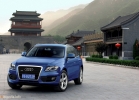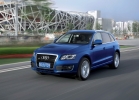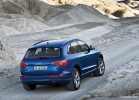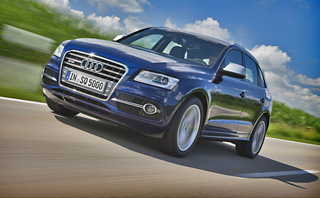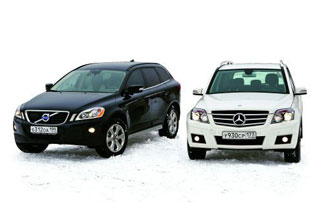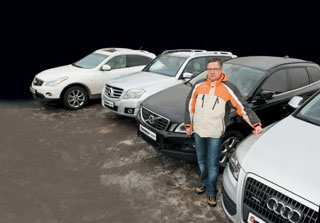Audi Q5 test drive since 2008 SUV
Electric metabolism. Long test Audi Q5 Hybrid
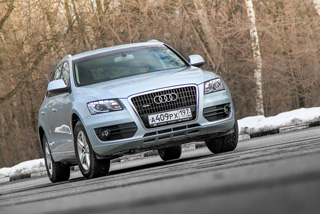 I met with Audi Q5 Hybrid more than a year ago in Ingolstadt, where the company conducted a technical seminar using its electric technologies. Then the hybrid version has not yet been produced (pre -production samples rolled out of journalists), and marketers and engineers spoke more than evasively about the prospects for its appearance on the Russian market. But, be that as it may, the hybrid modification this winter has nevertheless reached Russia. Is this not a reason to take her for a long test, especially since in the greenhouse Ingolstadt on a hybrid crossover I managed to drive only fifty kilometers ...
I met with Audi Q5 Hybrid more than a year ago in Ingolstadt, where the company conducted a technical seminar using its electric technologies. Then the hybrid version has not yet been produced (pre -production samples rolled out of journalists), and marketers and engineers spoke more than evasively about the prospects for its appearance on the Russian market. But, be that as it may, the hybrid modification this winter has nevertheless reached Russia. Is this not a reason to take her for a long test, especially since in the greenhouse Ingolstadt on a hybrid crossover I managed to drive only fifty kilometers ... In our editorial office, Cross is already two months, for which we have traveled 2500 kilometers behind the frost, snow and dirt. But, before starting the story of the behavior of a hybrid drive in our conditions, we recall the materiel. So, the main components of the Audi Q5 combined drive is a two-liter 211-horsepower turbocharged motor 2.0 TFSI, a 45-horsepower synchronous motor-generator and an eight-speed planetary automatic transmission combined in one unit. In size, the latter corresponds to the standard one, so, in general, the layout of the crossover has not changed. Unless only the traction lithium-ion battery Sanyo, located above the rear axle, ate all the space for the spare. The drive, like all Q5, is full and permanent with a self -blocking inter -axial differential Torsen. And this, by the way,, coupled with a 200-million road clearance, promises good cross-country ability.
In short, recall the principle of action and dignity of hybrids. They give advantages only when operating in a city or mixed mode, when frequent accelerations and deceleration take place. During inhibition, the kinetic energy of movement, which an ordinary car spends on heating the brake mechanisms, is converted by the generator engine into electrical energy (recovery braking mode). The latter is stored in the battery and is used again to move and power auxiliary systems. Thus, the fuel consumption in the city of hybrids under a successful combination of circumstances may even be less than on the highway at cruising speed. But, it was smooth on paper ...
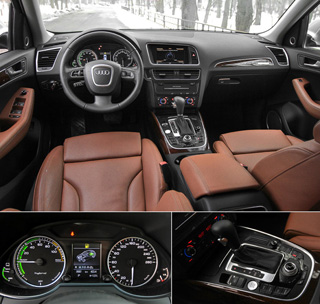
Q5 Hybrid received an original dashboard. On the left, instead of an indicator of the engine temperature indicator, the battery level scale, and the tachometer is replaced by a pointer demonstrating the operating modes of the power plant. A 3D-pictogram is displayed on the liquid crystal display of the on-board computer, which clearly demonstrates everything that happens with the drive. This picture can be displayed on the monitor of the multimedia system MMI (Multi Media Interface), located on the central console
Cold and battery electricity are two strongly conflicting things, we know from experience. And although auto engineers guarantee the full -fledged operation of a hybrid drive at temperatures up to 10O C, in realities this is not entirely true: electric trim is often not available at minus five. Of course, even at very low temperatures, the hybrid to the best of its capabilities generates and storages electricity in the battery. It contributes to the overall electric metabolism, but the use of the electricity is inversely in proportion to a decrease in the temperature of the surrounding air. With the notorious minus of five, the engine of the internal combustion of the Kew-fifth threshes almost without interruptions, only occasionally shut up during stops at traffic lights or in traffic jams.
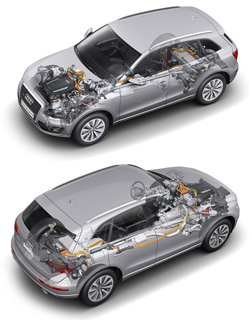
The power unit and battery used in Q5 Hybrid can be used in other Audi models with a longitudinal location of the engine. For example, in the new A8, A6 and A6 AVANT
It turns out that in cold conditions, our experimental person behaves similarly to cars with a regular start-stop system. Why? Everything is simple. In frost, a large amount of energy is spent on heating and ventilation of the cabin, heating the glass, mirrors, seats. If you are in the cork, you will need to turn on the air conditioner with an activated recirculation system (here its compressor is given by an electric motor) to prevent fogging and freezing of glazing. Add to this the work of headlights and other lighting equipment of cleaners, audio systems, etc. ... But most importantly, you need to nourish the steering electrical power and electric pumps of an automatic box and a vacuum brake amplifier. During braking, we simply do not collect such an amount of energy that with the ICE with the disconnected ICE to traction and the power of this farm. In addition, with a decrease in temperature, the internal resistance of the battery increases greatly, and this is, alas, losses that reduce the effectiveness of the system.
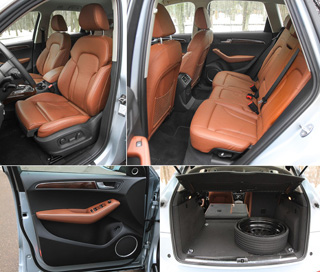
There are no complaints about the ergonomics of the driver's seat. Behind the space in abundance. The possibilities of transforming the cargo compartment are the same as that of the usual version of Q5, the cut back of the rear chair is adjustable by inclination. There are no spare wheels and docking in Q5 Hybrid, the traction battery took the underground underground. For repair and pumping the wheels on the road, only sealant and compressor are provided. No jack, no cable, no shovel ... The doom that you see in the trunk was given to us in the representative office of Audi, just in case, still, still, there is nothing to the test
And what is the expense? In frosts below 150 C Q5 Hybrid in the city consumed 13-15 l/100 km of path. The operating mode, as they say, do not particularly fry without fanaticism, but we do not save. Although without sharp firefights in the stream also can not do. As soon as the temperature began to rise, the appetite naturally began to deteriorate. Energy for heating the cabin and power heaters are needed less. ICE for heating is used less often. And the battery with an increase in the ambient air is more efficient (resistance below), it takes more willingly and gives the charge.
What is the effect? When it warmed up to about zero, fuel consumption decreased to 12-12.1 liters per hundred. My personal economy record in the city is 9 liters. I traveled, experimented, adapted a clear thing, you need to forget about sharp accelerations and high speeds. It is important to constantly think at what moments you can recover the maximum possible amount of energy. Conclusion? A hybrid car itself is half the old. The main reserves of economy are hidden in the strategy of behavior in the intricacies of traction and braking. Management runs everyone. And what outside the city? Here, the flow rate is naturally lower and more stable. On the highway at cruising 90-120 km/h Q5 Hybrid eats about 7.5-8 liters per hundred kilometers, and this is regardless of temperature. Soon we compare the consumption of a hybrid with a regular gasoline version. And at the same time we will monitor the dynamics of fuel consumption with an increase in temperature.
The habits of the hybrid from the standard 211-horsepower gasoline modification are slightly different. The mass that has increased to two tons (+130 kg), which required the installation of more rigid springs and shock absorbers, increased. On irregularities, Q5 Hybrid is tangibly shaking, especially from behind. The unknown system of dynamic stabilization here is strictly configured here, the center of the masses above, the machine is harder and stronger to skidding, because the main increase in the weight of the hybrid (compared to conventional versions) came on the battery located above the rear wheels. But the traction is not very convenient, especially in traffic jams during frequent touching and slowdown. Acceleration and slowdown is always either more or less than you want. The peculiarity is associated with the inertia of the generator motor and the clutch algorithm that connects it to the transmission, and the engineers recognize this.
The accelerated dynamics, despite the increased mass, the hybrid has a little better than the gasoline analogue of 7.1 seconds to hundreds of 7.2. After all, in the forballow mode, both engines accelerate the car. But there is a cover: the fact is that with the devastated battery, acceleration is somewhat worse than electric trotter from the game. In order not to strip at the most inopportune moment, this must always be remembered.
A confident start is not everything that gives a constant all -wheel drive. The blocked center differential and a 200-mm clearance make Q5 Hybrid very interesting on moderate off-road and bad coatings. Full -wheel drive with a torsen in the handout willingly dealt with slippery coatings, and the anti -boom system adequately impulses slows down from the wheel coating and allows you to very dashingly crawl up on rollers that have good contact with the coating. It is interesting that electronics bites the wheels rotating, even if the anti -boom system for forgetfulness is disabled. That is, the computer recognizes this situation and acts appropriately, thanks to the engineers!
But we must remember that the abilities of transmission and geometry are not unlimited. In addition, the hybrid does not have the protection of the power unit and the main transfer. The motor and box are covered only with a plastic mudguard ski. I force deep ruts in the melted tamped spring snow fearlessly. But it’s scary to climb in the field at random, what will happen if you fly on a stone or a frozen earthen shaft hidden under the snow? How much will the repair of a hybrid power plant cost?

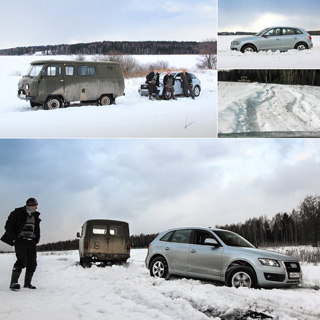
The search for a tractor around the district on Sunday evening a hundred kilometers from Moscow did not lead to anything. Fortunately, fishermen-saving fishermen, who, with great difficulty, managed to draw in this area, had not only gear and shovel, but also an all-wheel drive UAZ with them. Friends, thank you so much! Hooray! Always good cool!
And yet I decided on it! When the Q5 Hybrid could not crawl on the deep snow on his deep snow and sat thoroughly on the belly, one curious thing of the anti -wings system with two wheels posted diagonally did not work. Electronics does not even make attempts to intervene and transfer the moment to other rollers. The logic is simple: protect the transmission from excessive loads. In general, our hybrid had to pull out of the trap with the help of extraneous power, shovels and such and such a mother. Pulled out! Continuation in the following series.
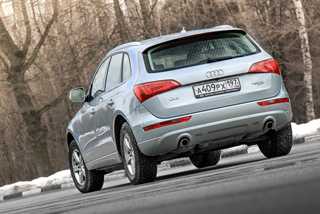
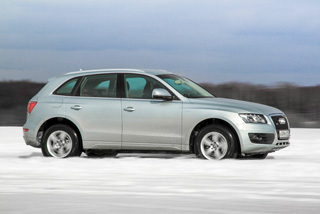
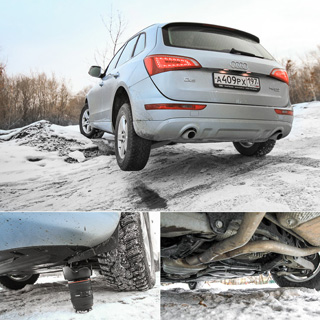
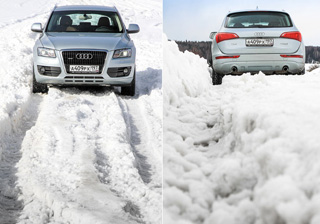
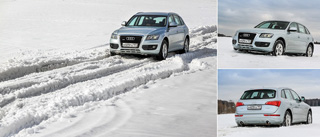
Technique
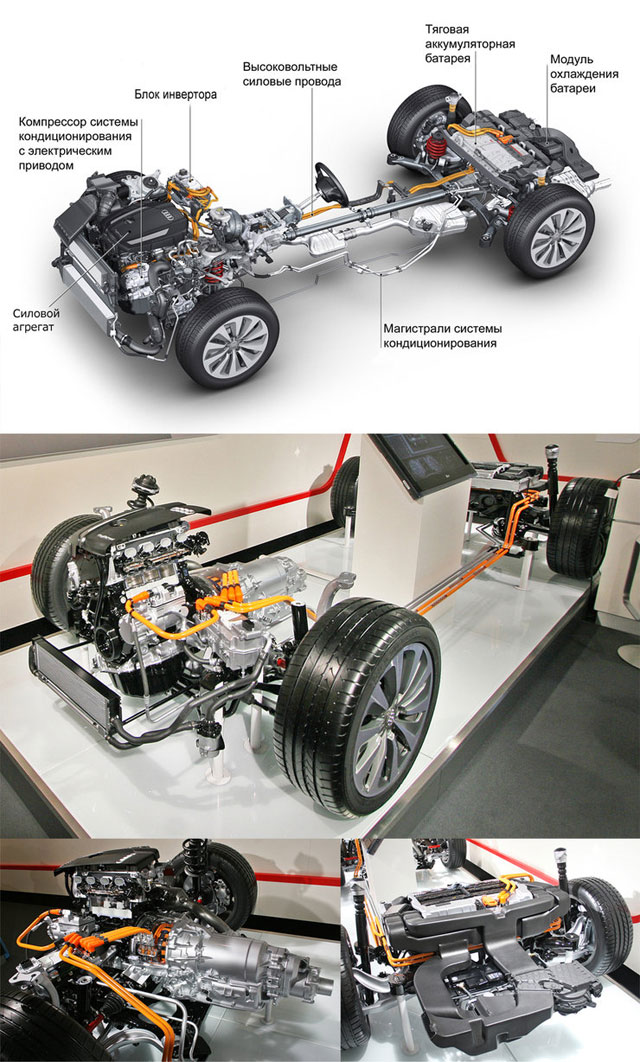
The power unit (left below) is made up of an internal combustion engine, a synchronous engine-generator, an automatic eight-speed planetary gearbox and two clutches that connect them integrated into the rotor of an electric machine.
DIS two -liter turbocharged engine 2.0 TFSI with direct fuel injection, it produces a capacity of 211 hp. (155 kW) and develops the maximum torque of 350 nm in the range from 1,500 to 4200 rpm. A gas distribution mechanism with phaseuries and a system for adjusting the length of the AVS valves (Audi Valve Lift System). Since the engine is periodically disconnected, the drive of the air conditioning compressor and the cooling system pump had to be made electric. The brake amplifier also received an electrical drive. The drives are powered by a traction battery. There is no familiar starter here, its role is played by the generator motor.
Synchronous electric motor with constant excitement plays the role of the generator and starter for the internal combustion engine. He gives out a power of 45 hp. (33 kW) and torque 211 nm. The electric motor and ICE have a common cooling system.
For charging a 266-volt battery (right at the bottom), constant voltage is necessary, the generator consumes and produces alternating voltage. Such a machine is more profitable in its characteristics, but requires an inverter. The optimal temperature regime is maintained by air cooling with the air conditioning system.
The inverter (converts alternating current into constant and vice versa) has a volume of six liters and weighs only nine kilograms, which is half the previous variation used in the Audi Q7 Hybrid concept frame. The inverter processes up to 40 kW of power at a rated voltage of 266 volts, which is equivalent to continuously turning on/off 666 incandescent lamps with a capacity of 60 watts each with a duration of a cycle into several hundredths of a second. The main part of the inverter module, consisting of several interconnected power bipolar transistors. Innovative technologies have significantly reduced the size and mass of the electronic unit. Cooling is provided by a separate liquid contour. The semiconductors of the block heat up to temperatures exceeding 100 s
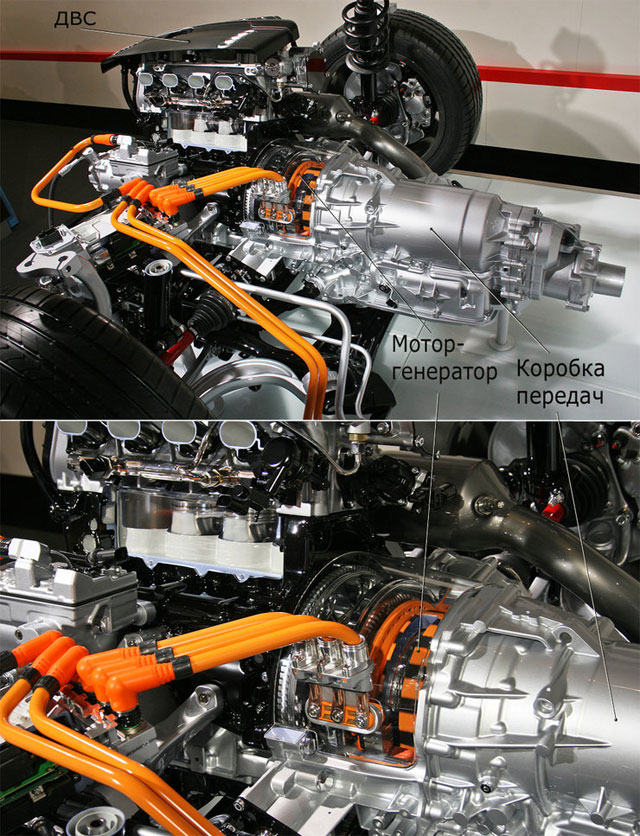
The eight -speed Tiptronic gearbox on a hybrid Q5 is dispensed with a hydrotransformer. Instead, a generator engine and two clutch clutch working in an oil bath were integrated into the crankcase. Clutch are used to connect and disconnect the electric motor, gasoline engine and gearbox. When the internal combustion engine is turned off, the oil pressure in the hydraulic system of the gearbox is maintained by an electric pump
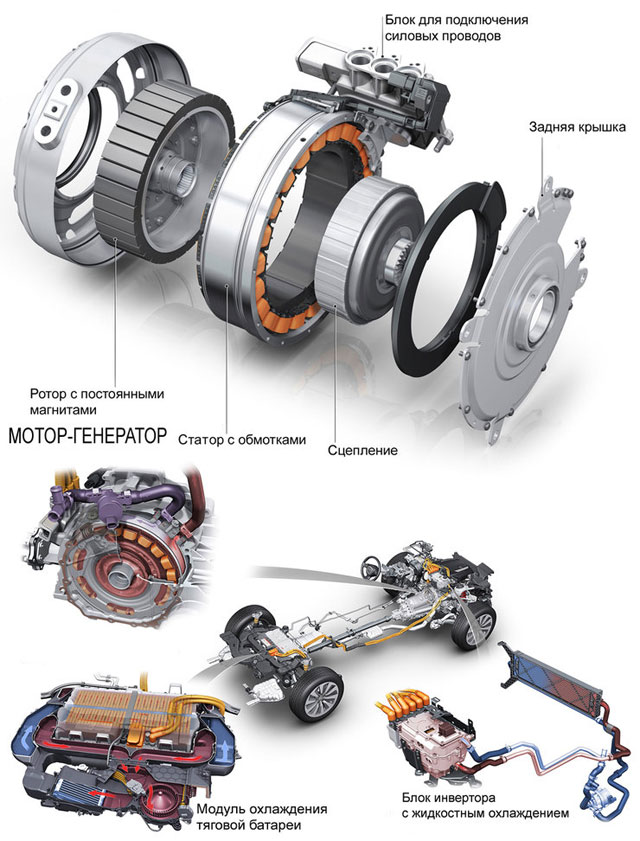
The lithium-ion battery is located in the back of the body, under the floor of the trunk, but so that the useful volume of the latter was almost not injured. The batteries for Audi are supplied by Sanyo, the service life of 10 years, the declared temperature at which they can be fully operated, minus 10 C is occupied by the battery, along with the fasteners and the air ducts for cooling, 80 liters of space, and its weight is 38 kg. The battery consists of 72 cells, the operating voltage at the terminals of 266 volts, a capacity of 1.3 kWh. The battery has an air cooling system, and a conditioning system can be used to cool the air supplied between the cells. The cooling circuit of the battery received its evaporator, but the branch is connected to the main climate control system. If the battery temperature exceeds +55 C (for example, if the car stood in the sun for a long time or was operated in difficult temperature conditions with a large number of acceleration cycles), the electric drive will automatically turn off (otherwise there will be a threat of explosion of cells from overheating). In this case, Q5 Hybrid will be able to move only under the influence of ICE
Vitaly Kabyshev
Photo: Vitaly Kabyshev, Katerina Sorokina and Audi
Source: Auto.mail.ru
Video test drives Audi Q5 since 2008
Video crash tests Audi Q5 since 2008
Audi Q5 test drive since 2008
Audi Q5 Crash Test since 2008
Krassh Test: Detailed Information92%
Driver and passengers
32%
Pedestrians
84%
Children-passengers
71%
Active security system



